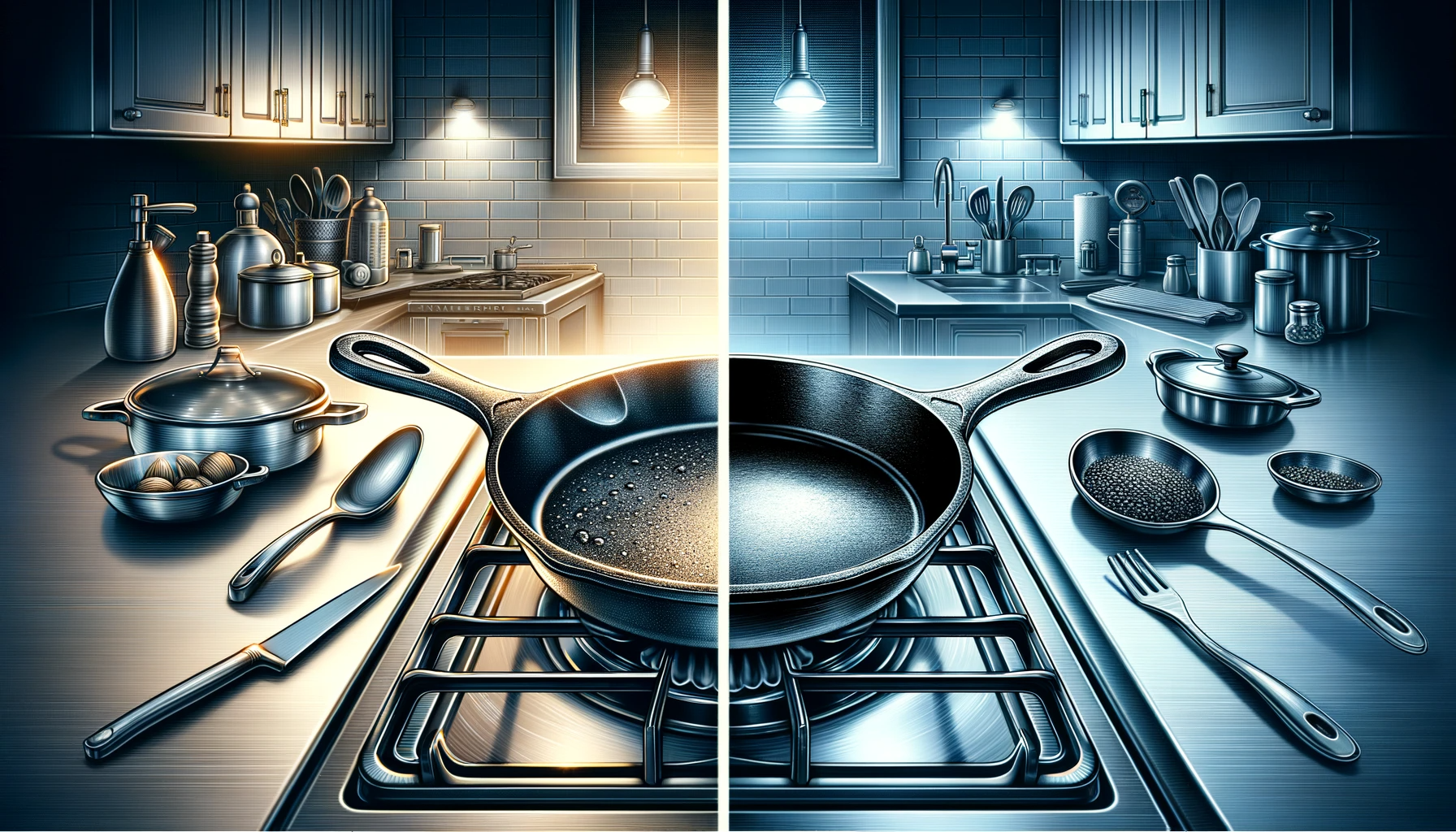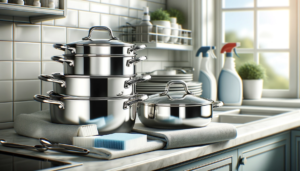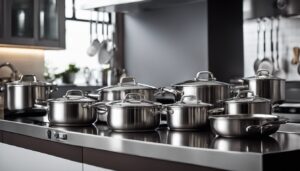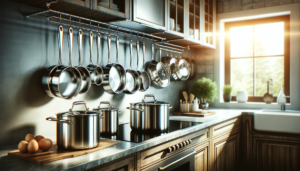Is your cookware drawer a jumble of mismatched pans? Struggling to decide between stainless steel vs cast iron for your next investment?
Stainless steel and cast iron both make excellent cookware materials, but the differences in durability, cooking abilities, care and pricing means certain models fit individual cooking needs better.
Before picking sides in the stainless vs cast iron cookware debate, let’s dive in to understand their distinct advantages to decide what’s best for your kitchen.
Stainless Steel vs Cast Iron Cookware
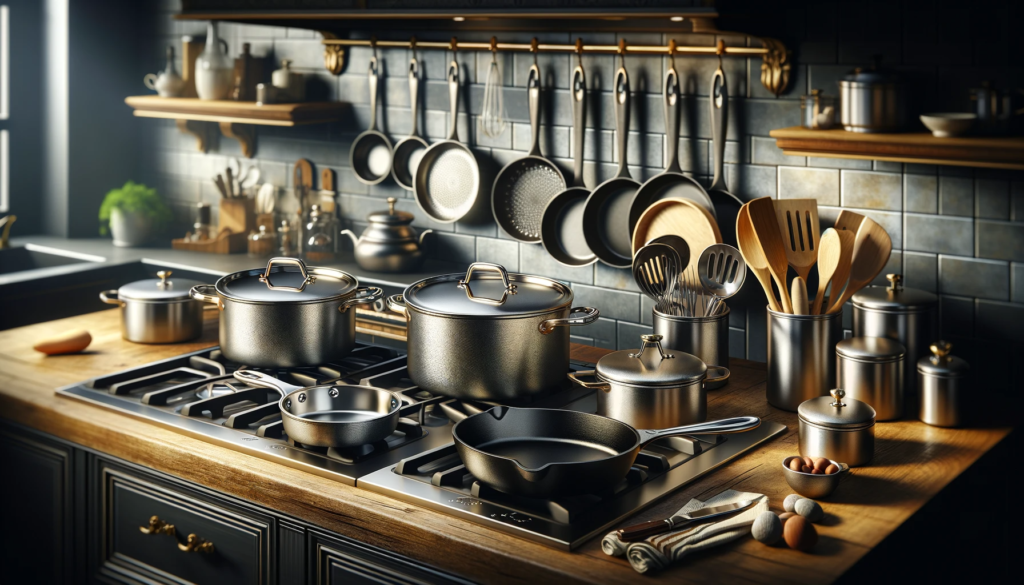
If choosing between stainless steel and cast iron cookware, the basic trade-off is durability and ease of use versus heat retention and nonstick properties.
Stainless steel is extremely durable, more resistant to corrosion, dishwasher safe, and requires minimal maintenance.
However, cast iron offers superior cooking performance with excellent searing due to unparalleled heat retention and distribution.
Ultimately both materials make quality cookware, but your personal cooking style preferences and priorities for maintenance should guide your decision.
Now let’s dive deeper into the pros, cons and key differences between these two classic cookware materials.
Durability and Longevity
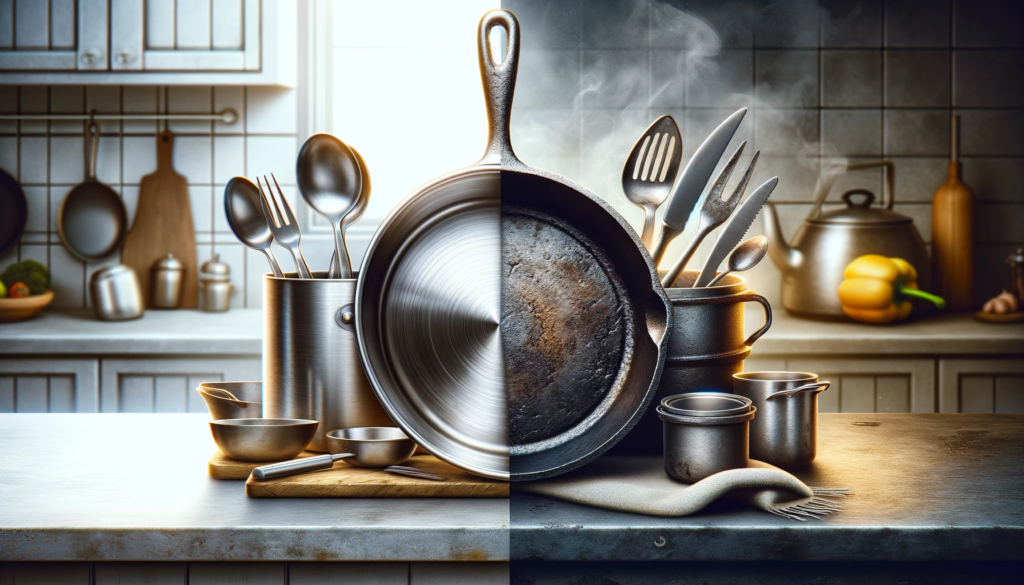
Stainless steel cookware is highly durable and resistant to damage from normal kitchen use.
Pans and pots made from stainless steel alloys containing chromium and nickel stand up very well to frequent cooking and cleaning without developing dents, warps or scratches easily during use.
The stainless steel allows pans to maintain their shape and appearance for many years when cared for properly.
Using non-abrasive cleaning materials is recommended to help stainless steel better withstand typical impacts from metal spatulas and utensils that can potentially scratch or scuff the finish over a long period of time.
However, overall stainless steel cookware can deliver reliable cooking performance for extended periods with basic maintenance to preserve the durability.
Cast iron cookware is renowned for its extreme durability and heirloom lifespan.
Cast iron pans and Dutch ovens are capable of lasting for generations of continuous cooking use when cared for correctly.
And while stainless steel can scratch or dent from excessive force or abrasion, minor scratches or dents to a cast iron pan will rarely impact its cooking abilities significantly.
Even if the surface appearance deteriorates, cast iron will still provide superb heat retention for searing, frying, braising and more.
The pure iron material ensures resilience against cracking or breaking during stovetop usage.
As an essentially non-delicate material resistant to shattering or permanent damage under normal circumstances, cast iron offers multi-generational cooking dependability.
Stainless steel alloys containing at least 18% chromium substantially resist rust corrosion and staining compared to standard carbon steel.
The chromium in quality stainless steel forms an invisible passive layer protecting the surface from oxidation reactions when exposed to moisture.
As a result, stainless steel cookware does not rust readily during typical kitchen use including cleaning and storage.
Proper drying after washing is still best practice to promote maximum rust protection, and neglected pans may eventually show corrosion from extreme moisture exposure over time.
But in general, stainless steel maintains anti-stainining, water-resistant properties far better than materials like cast iron or carbon steel.
Cast iron is prone to rust formation without proper maintenance unlike stainless steel.
While extremely durable, cast iron contains purely iron which can oxidize into rust when introduced to oxygen and moisture.
Failing to dry cast iron thoroughly after cleaning leaves lingering water droplets that invite rust.
Storage methods are also important – hanging cast iron pans to promote air circulation reduces dampness versus stacking which traps humidity against surfaces.
Since preventing rust requires diligent dryness and oiling, stainless steel offers more casual care and maintenance without compromising on longevity overall.
Cooking Performance
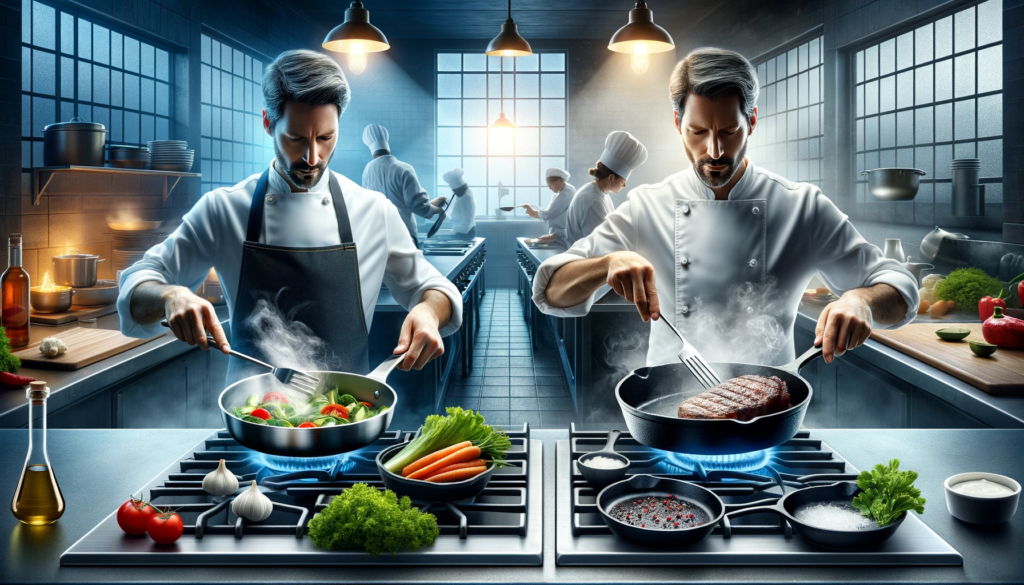
Cast iron pan offer exceptional cooking performance when it comes to heat retention and heat distribution compared to stainless steel options.
Once fully preheated over a burner flame or other heat source, cast iron’s thick and dense material composition enables superior absorption and retention of heat energy.
Rather than quickly releasing this thermal energy after removing from the stove burner, quality cast iron pans retain absorbed heat very effectively across the entire cooking surface.
This allows for precise temperature regulation, making it simpler to reduce intense heat levels to optimal frying and searing intensities.
Cast iron offers gradual, adjustable dissipation of stored heat energy for outstanding control during cooking processes like deglazing a pan sauce.
In addition to stellar heat retention, cast iron also provides very even and efficient heat distribution free of unpredictable hot or cold spots.
The seasoned iron material enables uniform heat conductivity across the length of frying pans and oven dishes.
Foods will brown and crisp consistently when searing over the entirety of a cast iron skillet rather than random locations.
Soups and braised meat simmer evenly without the need for constant stirring or rotation when cooked in a Dutch oven.
By fully preheating an entire piece of cast iron cookware, the distribution of existing heat is balanced and reliable during any cooking techniques.
Stainless steel cookware by contrast demonstrates relatively poor heat conductivity overall leading to inferior cooking performance in many situations.
Rather than absorbing and retaining burner heat, quality stainless steel alloys are designed for maximum energy reflection down into the pan.
But the heat transfer through the stainless steel material itself relies on conductor metals like copper and aluminum in tri-ply designs sandwiched between layers of stainless steel.
The purity of stainless steel alone renders uneven hot and cold spots during most stovetop cooking.
Without a more conductive heat core material, stainless steel pans develop intense heat zones particularly closest to direct burner contact.
These random hot spots generate inconsistent cooking between the center of a pan compared to outer edges.
Without any special surface coatings, stainless steel pans and pots also provide essentially no nonstick ability inherently.
The smooth stainless steel walls do not possess natural release properties when searing delicate proteins like fish or frying eggs.
Generous amounts of cooking fat or oil must be used to prevent proteins and other foods prone to sticking from fusing to cooking surfaces.
By contrast, well-season cast iron develops nonstick properties from oil polymerization onto the pores of iron creating a natural release barrier.
So cast iron relies much less on butter, oil or other fats for releasing cooked foods cleanly after the nonstick seasoning is properly built.
Ease of Care and Maintenance
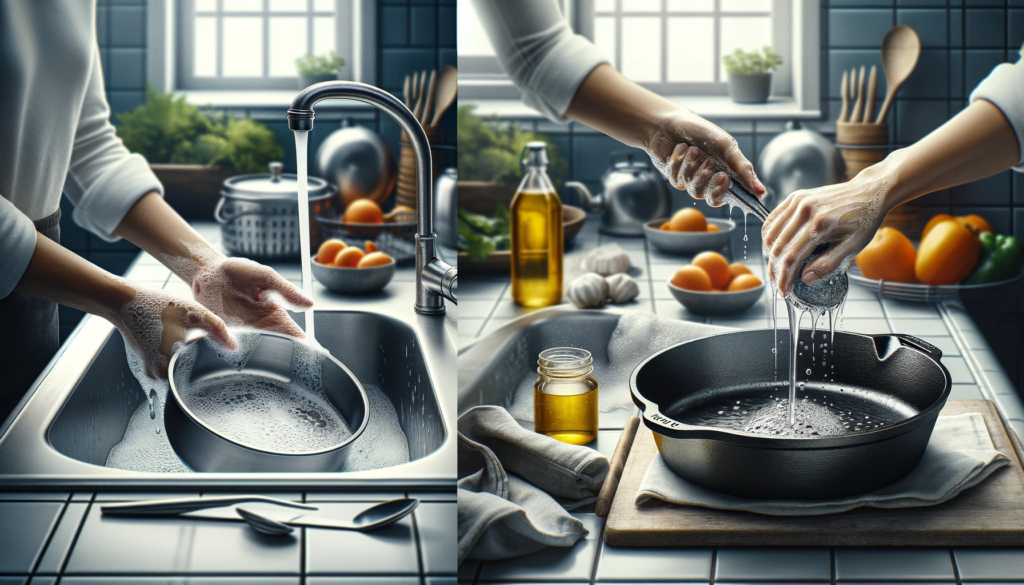
Stainless steel cookware generally proves easier to clean and care for after use than cast iron alternatives.
Thanks to stainless steel’s durable and water-resistant properties, pots and pans can be washed using typical dish soap and water without risk of damage over time.
Stainless steel cookware surfaces also withstand being cleaned with non-abrasive scrubbing pads or brushes to remove stubborn residues or staining after cooking more tenaciously.
Most stainless steel pans specify “dishwasher safe” cleaning as well, allowing convenient sanitization combined with household plates and utensils cleaning loads.
No special maintenance routines are required before or after use – simply washing, drying and storing is sufficient.
Cast iron by comparison has specific care and cleaning requirements in order to preserve optimal cooking performance and longevity.
The oil-based seasoning finish that builds up over time from repeated cooking use followed by oiling creates natural nonstick properties.
But this seasoning layer must be maintained properly through cleaning methods.
First, cast iron should never touch harsh dish detergents which can dissolve away built-up seasoning and require re-layering from scratch.
Manual cleaning by hand is recommended using hot water, coarse salt for abrasion, and stiff sponges or scrub brushes to remove residues while retaining seasoning.
Excess moisture is cast iron’s enemy so quick, thorough drying to avoid rust corrosion before oil application completes maintenance.
Stainless steel earns its naming from an inherent resistance to stubborn staining or ghosting – the absorption of food flavors and residue discoloration into the metal itself over time from ingredients like spices, tomatoes, or red wine vinegar.
While not fully nonporous, quality stainless steel strongly limits staining issues as long as moderate scrubbing is applied during washing.
By contrast, cast iron preparation when new emphasizes seasoning the untreated metal to fill in pores and create a nonstick barrier preventing food absorption.
But neglecting maintenance of this oil barrier after heavy cooking invites staining or rancid flavors impairing cast iron performance until re-seasoned correctly.
Stainless steel withstands staining issues without ongoing time investments.
Proper care is essential to prevent rust damage on cast iron pans and Dutch ovens after each use.
Allowing moisture to pool and evaporate on cast iron leaves oxidation in its wake compared to faster drying.
Therefore, hand washing cast iron immediately after cooking avoids letting food debris accumulate while the metal cools.
Shouldering the weighty heft of larger cast iron pots still hot from the oven raises risk of accident too compared to cleaned stainless steel soaking outside the sink.
Letting hot cast iron air dry risks uneven moisture becoming trapped against surfaces.
Actively towel drying ensures no rust-inviting dampness lingers before massaging a thin fresh oil layer protecting against oxidation until next usage.
Weight and Heft
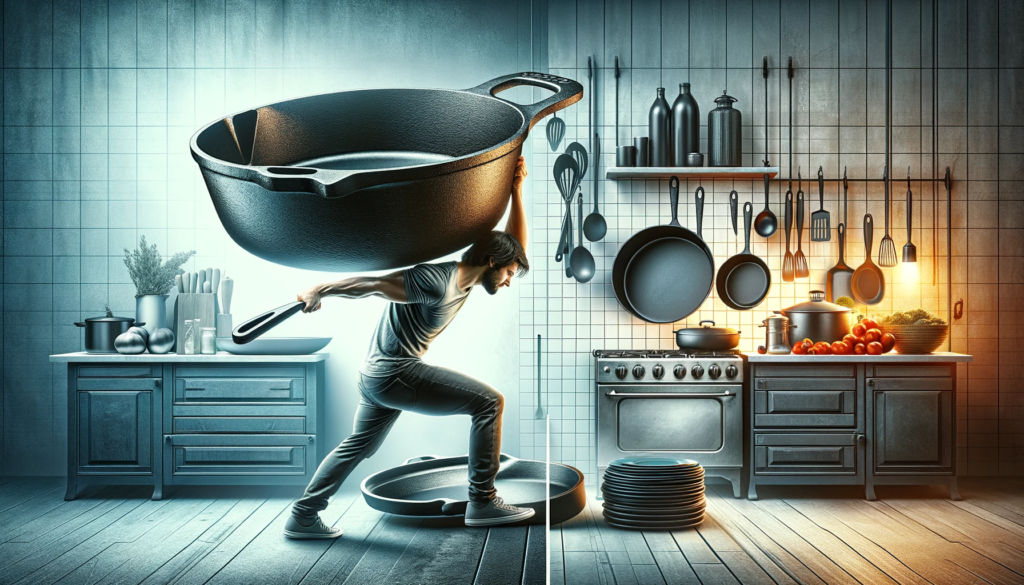
An obvious difference between stainless steel pots and pans versus traditional cast iron is the sheer weight and heft distinction.
Cast iron consists of an extremely heavy material – far heavier than stainless steel options – owing to its pure iron composition.
For example, a 12-inch cast iron skillet can weigh up to seven or eight pounds with thicker casting while a stainless steel comparison might hover below five pounds maximum.
Expanding to the popular cast iron Dutch oven cuts versatility for braising meats or simmering stew compares to lighter stainless models.
Large cast iron ovens which offer enough capacity to feed four to six people can weight in excess of 15 pounds requiring two hands and strength to maneuver in and out of ovens safely or when transferring contents to serving dishes.
Without sufficient grip, dropping heavy cast iron risks damage to both the heirloom-quality pot itself or the floor receiving the impact.
While burdensome for storage purposes and arguably dangerous for those with wrist injuries or limited strength to handle safely, the extreme heaviness and heft of cast iron cookware does lend certain cooking benefits stainless steel cannot match.
Once heated thoroughly over a burner or in a hot oven, cast iron’s thermal mass allows the dense material to efficiently absorb significant heat energy before reaching optimum temperature.
This means well-made cast iron takes longer to fully preheat compared to relatively light stainless steel, but offers unparalleled heat retention once ready for cooking.
Rather than releasing absorbed heat quickly after removing a burner source, cast iron’s thick walls retain energy which distributes evenly across the surface delivering incredible searing and frying consistency.
Lightweight stainless steel skillets offer responsiveness in adjusting temperature fast but sacrifice sustained usefulness where outstanding heat retention shines.
Reactivity and Food Interactions
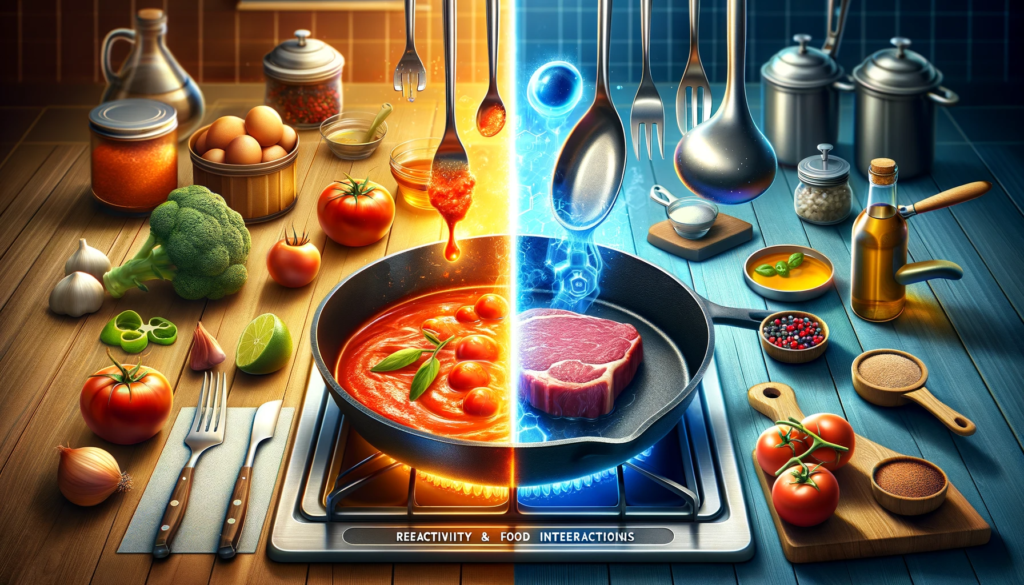
Stainless steel earns reputation for its neutral, non-reactive properties essential for diverse cooking projects.
Quality stainless steel contains a mixture of steel complemented typically with at least 18% chromium to produce oxidation resistance preventing metal leeching into foods during contact.
This means acidic ingredients like tomatoes, citrus, or wines cook safely without corrosive reactions or releasing metallic flavors making stainless steel ideally suited for delicate seafood dishes.
The inert nature of high-quality stainless steel allows both quick sautéing and slow-simmering of dishes imparting no metallic or chemical reactions destroying subtle flavor complexities – merely blank canvas practicality.
Cast iron cookware conversely possesses known elemental reactivity engaging in chemical exchanges with certain food contents during preparation.
While bare molten iron accepts seasoning from repeated oil coatings followed by cooking use over time, direct contact between iron atoms and acidic liquids pulls ferrous molecules into the food itself.
Braising or simmering wine-heavy stews or Italian marinara sauce for hours extracts iron bits interacting with acids weakening the structural integrity of iron over gradual erosion.
So while light metallic hints can complement hearty red meat braises, other subtle seafood may suffer unwelcome overt stale blood notes or dull fruit brightness from excessive iron leeching over time.
The porous nature of cast iron must be filled in through repeated oil-heat cycles bonding within gaps along the grain.
But acidity from tomatoes, vinegar in barbecue sauces, or wine flows readily through vulnerable microscopic spaces not fully sealed.
Extended slow-cooking then drags iron deposits into the mix unlike nonporous stainless steel blocking passage.
Quick cooking avoids saturation issues but best practices suggest reserving cast iron for charred steaks or bacon frying benefitting from iron accents while keeping stainless for egg scrambles and buttery sauce reductions accurately reflecting their pure origins.
Whilecast iron provides a convenient vehicle for iron dietary uptake throughmetal leeching, excessive iron changes food properties negatively over time.
Acidic tomato sauce for example quickly strips iron molecules from seasoned cast iron dissolved by acidity weakening structural stability slowly.
Visible metallic freckles speckle affected foods with overly pronounced iron overwhelming brighter notes.
Delicate egg scrambles also suffer from trace iron seeping into creamy curds muting lighter flavors.
Stainless steel by contrast blocks metal transmission fully allowing purity of taste.
So while properly caring for cast iron includes rehabilitation from acidic assaults, stainless steel withstands corrosion leaving recipes equally balanced long-term.
Affordability
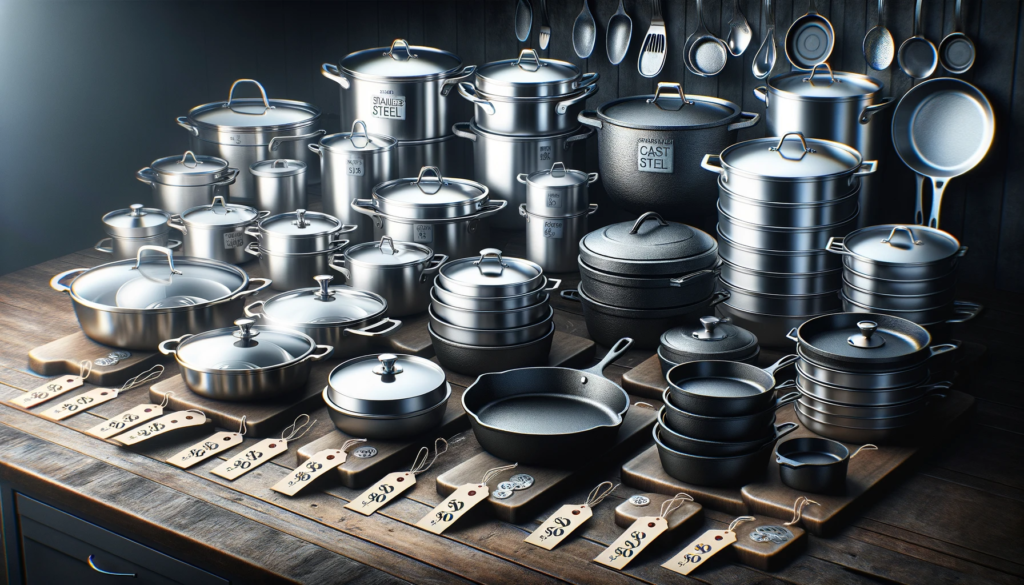
Cast iron remains highly regarded among kitchen value-seekers for good reason – traditional cast iron skillets and Dutch ovens cost mere fractions compared to equivalent stainless steel cookware.
Shoppers can acquire brand new cast iron pans across a range of sizes often between $20 to $50 retail from leading manufacturers known for hammered smooth finishes and superior heat retention properties.
Smaller starter pans may cost below $20 making cast iron highly affordable for those on tight budgets.
Premium enameled cast iron displays durability and decorative personality too but costs exceed basic varieties.
Modern stainless steel cookware usually surpasses cast iron pricing especially for core-based multi-ply products stacking aluminum or copper directly inside stainless walls for optimal responsiveness.
Bargain stainless steel may compete against entry-level cast iron but lack longevity guarantees or heat mastery seen from established cast iron producers assuring years of reliable performance for very reasonable investment.
For shoppers seeking maximum versatility combining stainless steel’s ease of use with cast iron’s thermal excellence and enamel protection, upscale cookware lines from Le Creuset or Staub retail around $300 or higher for a single Dutch oven.
Costs increase for spacious options accommodating multiple servings or meal types but the hybrid enamel coatings significantly enhance maintenance over raw cast iron.
While representing substantial upfront splurge, the durability and versatility of premium enameled cast iron lasts generations like heirloomartifacts providing everyday usage across numerous households collectively justifying significant expense similar to fine flatware or crystal glassware.
Value depends greatly on frequency of usage distributing cost over total lifespan.
For most home kitchens however quality stainless steel or basic American cast iron offers sufficient versatility more affordably without overspending.
Quality stainless steel costs noticeably exceed basic cast iron products while failing to match thermal properties in most cases.
But well constructed tri-ply options partnering conductive metals like aluminum or copper sandwiched inside stainless walls bridge gap considerably.
While roughly double the price or more of comparative cast iron pieces, premium tri-ply stainless steel cookware excels producing buttery sauces or tempering chocolate benefiting from adjustable lowering heat.
And contrasting cast iron vulnerability to moisture compromising rust protection or acidic ingredient erosion of seasoning layers, stainless steel withstands years of regular usage with only basic handwashing care retaining lasting appearance and cooking talents.
For households preferring lighter weight diversity across stove burners, ovens and dishwashers, stainless steel brings excellence over cast iron more applicable for specified high-heat purpose or decorative display.
Conclusion
Both stainless steel and cast iron offer durable, long-lasting cookware options.
Stainless steel is easier to care for and neutral tasting but cast iron provides unrivaled cooking performance.
Consider your budget, cooking style and maintenance preferences.
For most purposes, owning one stainless steel and one cast iron pan combines the strengths of both materials for versatile everyday cooking.
